
Bangkok, the capital of Thailand, is a dynamic metropolis blending rich cultural heritage with modern attractions. The city is famous for its stunning temples like Wat Arun and Wat Phra Kaew, bustling street markets, and vibrant nightlife. Whether you're exploring the Grand Palace, taking a boat ride along the Chao Phraya River, or savoring authentic Thai street food, Bangkok offers a diverse and unforgettable experience.
From luxury shopping malls to lively floating markets, the city caters to all types of travelers. Its efficient public transport, including the BTS Skytrain and MRT, makes it easy to explore. Whether for leisure or business, Bangkok welcomes visitors with warmth and energy.
1. What is the best time to visit Bangkok?
The best time to visit Bangkok is during the cool and dry season, from November to February. The weather is pleasant, making it ideal for sightseeing. The hot season (March to May) can be extremely warm, while the rainy season (June to October) sees frequent showers, though travel remains possible.
2. What languages are spoken in Bangkok?
The official language of Bangkok is Thai, but English is widely spoken in tourist areas, hotels, and major establishments. Basic Thai phrases can be helpful, but you can get by with English in most places.
3. What should I know before visiting Bangkok?
Bangkok has a hot climate, heavy traffic, and a rich culture. Use the BTS/MRT for transport, dress modestly at temples, and carry cash for street shopping.
4. What are the do’s and don’ts in Bangkok?
Do’s: Respect the monarchy, dress modestly in temples, try street food, and use public transport. Don’ts: Don’t touch someone’s head, point feet at people, drink tap water, or lose your temper in public.
5. How many days in Bangkok is enough?
For a quick trip, 3–4 days cover the highlights. A 5–7 day trip allows for deeper exploration, including day trips to nearby attractions.
6. How is the weather in Bangkok?
Bangkok has a tropical climate, meaning it’s generally warm and humid year-round. The temperature ranges from 25°C to 35°C (77°F to 95°F). The hottest months are from March to May, while the cooler months are from November to February. Expect heavy rainfall during the monsoon season (June to October).
7. How can I travel around Bangkok?
Bangkok has multiple transportation options, including:
-
BTS Skytrain – A fast, air-conditioned transit system ideal for avoiding Bangkok’s heavy traffic, with routes covering major shopping areas, business districts, and tourist attractions.
-
MRT Metro – A convenient underground train network connecting key locations, including business hubs, shopping malls, and transport terminals, offering a comfortable and efficient way to navigate the city.
-
Tuktuks
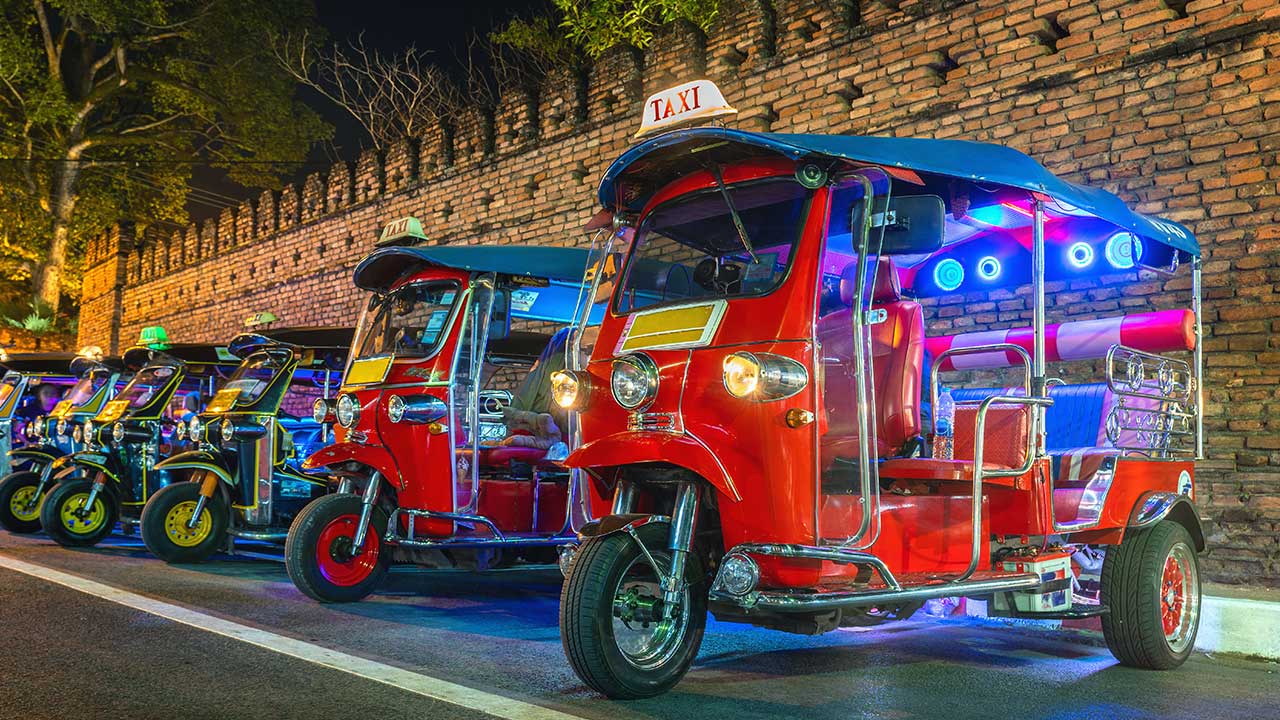 Colorful threewheeled vehicles offering a thrilling ride through Bangkok’s streets, best for short distances and negotiating fares beforehand to avoid overpaying.
Colorful threewheeled vehicles offering a thrilling ride through Bangkok’s streets, best for short distances and negotiating fares beforehand to avoid overpaying. -
Taxis – Metered and widely available, taxis provide a comfortable way to travel, but traffic congestion can cause long delays, so plan trips accordingly or consider alternatives.
-
Motorbike taxis A fast and budget-friendly option for solo travelers to navigate congested areas, ideal for short trips but requiring safety precautions due to Bangkok’s busy roads.
-
Buses and boats – Affordable transport options connecting different parts of the city, with local buses serving various routes and Chao Phraya River boats offering scenic rides to key landmarks.
8. What is the local food like in Bangkok?
Bangkok is a food lover’s paradise with a mix of street food and high-end dining. Some must-try dishes include:
-
Pad Thai
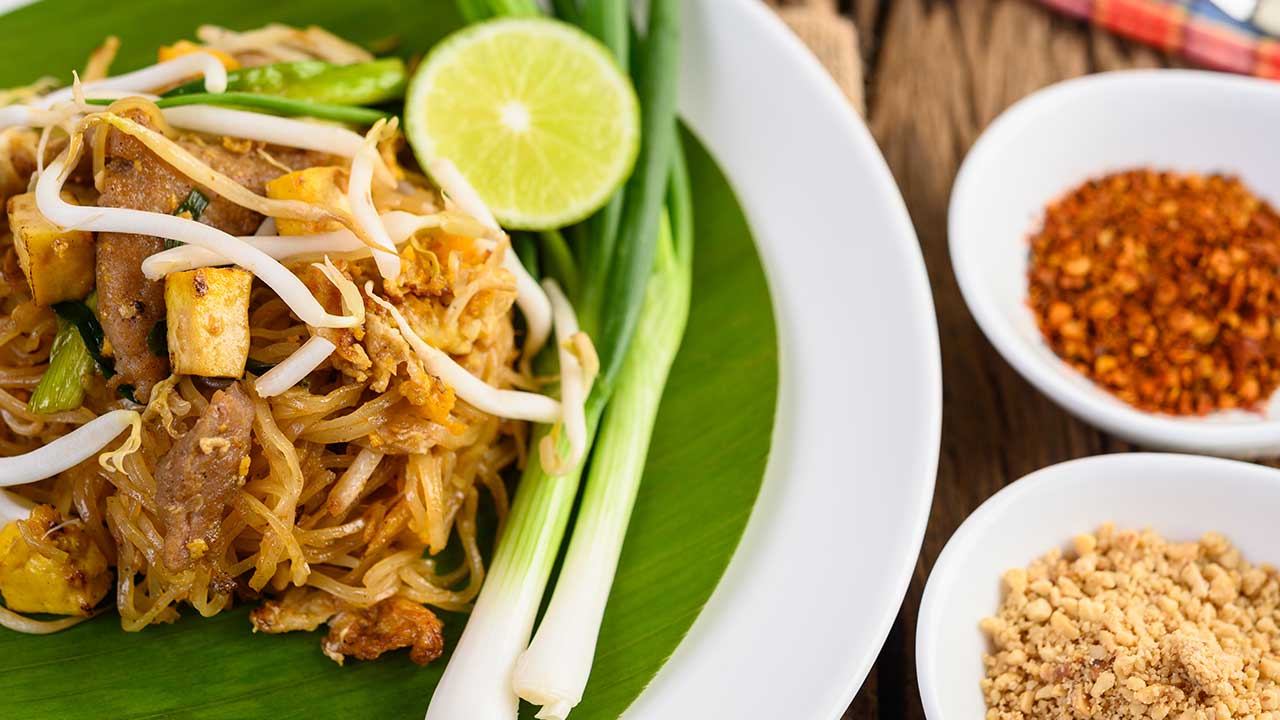 A classic Thai stir-fried noodle dish with shrimp, tofu, or chicken, tossed in a tamarind-based sauce, garnished with peanuts, lime, and bean sprouts for a perfect balance of flavors.
A classic Thai stir-fried noodle dish with shrimp, tofu, or chicken, tossed in a tamarind-based sauce, garnished with peanuts, lime, and bean sprouts for a perfect balance of flavors. -
Tom Yum Goong
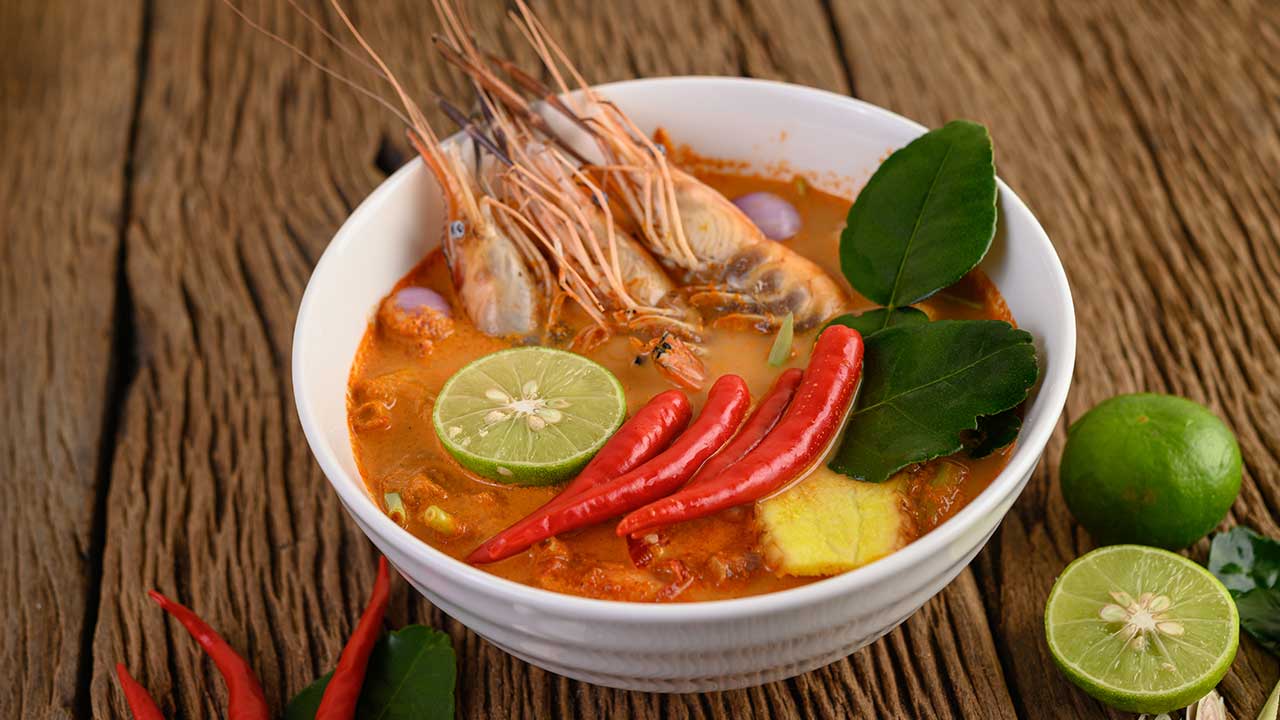 A spicy and sour shrimp soup infused with lemongrass, lime leaves, galangal, and chili, delivering a bold, aromatic taste that perfectly represents Thai cuisine’s signature flavors.
A spicy and sour shrimp soup infused with lemongrass, lime leaves, galangal, and chili, delivering a bold, aromatic taste that perfectly represents Thai cuisine’s signature flavors. -
Som Tam
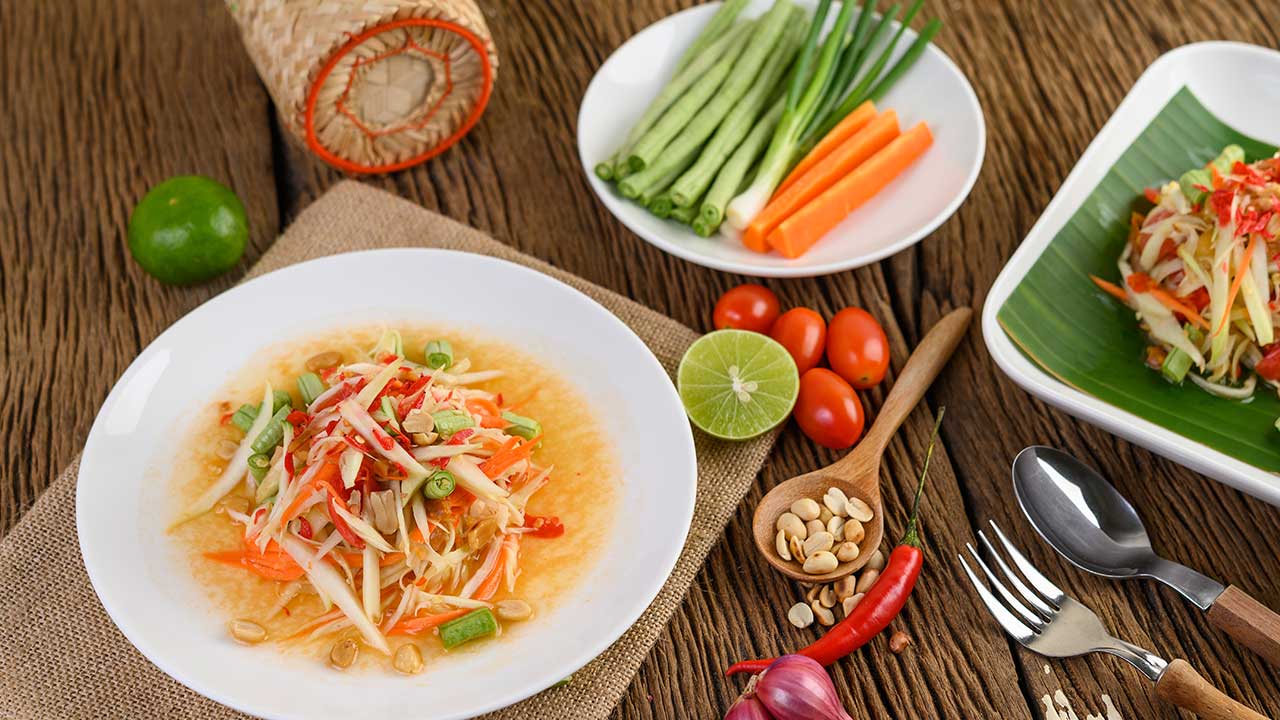 A refreshing green papaya salad mixed with chili, lime, fish sauce, and peanuts, offering a tangy, spicy, and slightly sweet flavor, making it a favorite Thai street food.
A refreshing green papaya salad mixed with chili, lime, fish sauce, and peanuts, offering a tangy, spicy, and slightly sweet flavor, making it a favorite Thai street food. -
Mango Sticky Rice
 A delightful Thai dessert made with ripe mango, glutinous sticky rice, and rich coconut milk, creating a perfect balance of sweetness and creaminess in every bite.
A delightful Thai dessert made with ripe mango, glutinous sticky rice, and rich coconut milk, creating a perfect balance of sweetness and creaminess in every bite. -
Boat Noodles
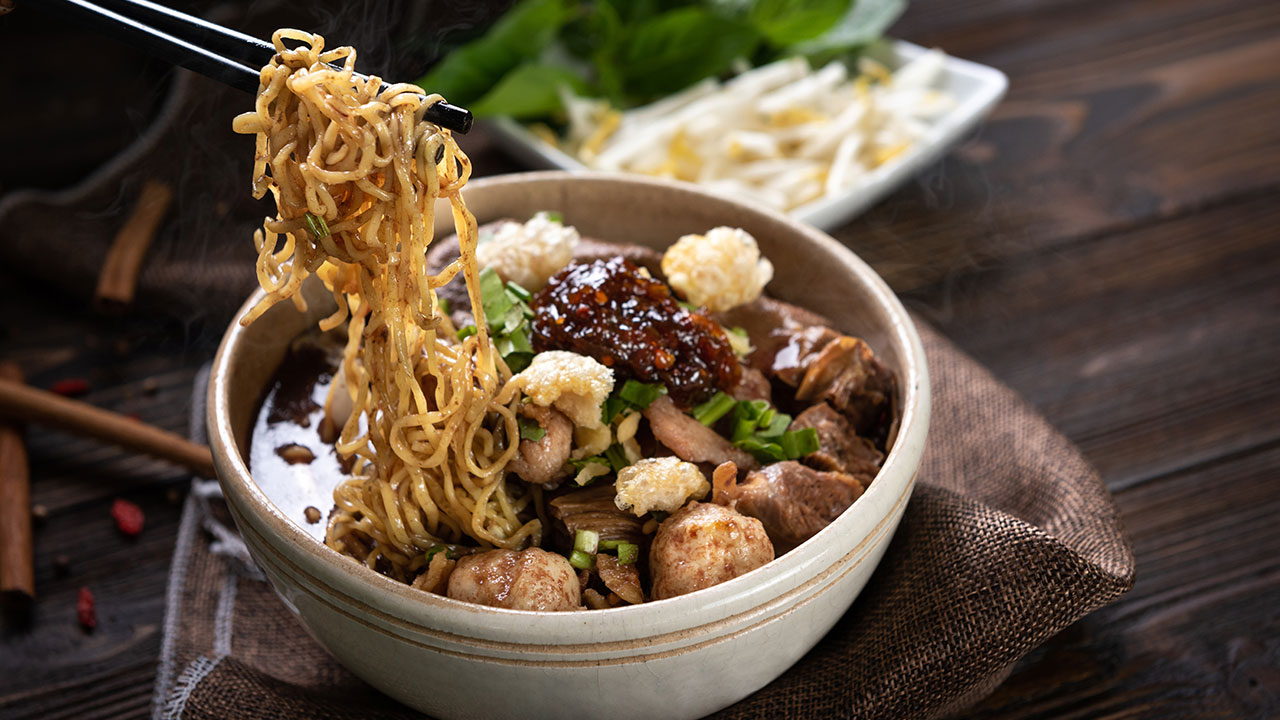 A rich and savory Thai noodle soup, typically served in small bowls, with pork or beef, dark soy sauce, and an aromatic blend of spices, giving it an intense, bold flavor.
A rich and savory Thai noodle soup, typically served in small bowls, with pork or beef, dark soy sauce, and an aromatic blend of spices, giving it an intense, bold flavor.
9. How safe is Bangkok for tourists?
Bangkok is generally safe for tourists, but it's always good to be cautious. Avoid scams, keep your belongings secure, and be careful in crowded areas. Women traveling alone should use reputable transport services at night.
10. Can I use international credit or debit cards in Bangkok?
Yes, major credit and debit cards are accepted in hotels, restaurants, and shopping malls. However, small street vendors and local markets often require cash, so carrying some Thai Baht (THB) is advisable.
11. What is the voltage and plug type in Bangkok?
Bangkok uses 230V electricity with a frequency of 50Hz. The plug types are Type A, B, and C, so bringing a universal adapter is recommended.
12. What are some famous tourist attractions in Bangkok?

-
Grand Palace & Wat Phra Kaew – A historic landmark housing the revered Emerald Buddha, featuring stunning Thai architecture, intricate golden details, and rich cultural significance in the heart of Bangkok.
-
Wat Arun (Temple of Dawn) – A breathtaking riverside temple with a towering spire adorned with colorful porcelain tiles, offering spectacular sunrise and sunset views over the Chao Phraya River.
-
Wat Pho – Famous for its massive reclining Buddha statue, this temple is also home to Thailand’s first public university and a renowned center for traditional Thai massage training.
-
Chatuchak Weekend Market – One of the largest markets in the world, featuring thousands of stalls selling clothing, handicrafts, street food, antiques, and more, making it a shopper’s paradise.
-
Chao Phraya River Cruise – A relaxing boat ride along Bangkok’s main river, offering stunning views of illuminated temples, historic landmarks, and the city skyline, especially magical at night.
13. Where can I go shopping in Bangkok?
Bangkok offers a variety of shopping experiences, from luxury malls to bustling street markets:
-
MBK Center
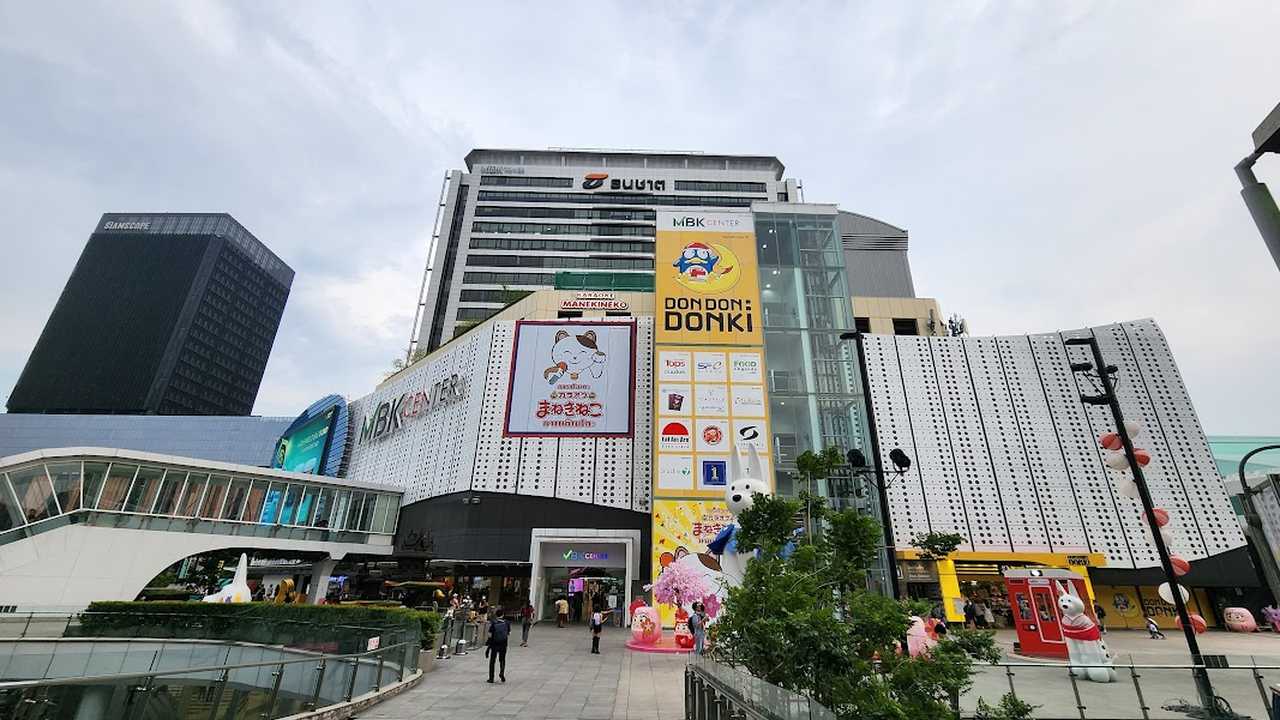 A popular mall for budget shopping, offering affordable fashion, accessories, souvenirs, and a vast selection of electronics at competitive prices.
A popular mall for budget shopping, offering affordable fashion, accessories, souvenirs, and a vast selection of electronics at competitive prices. -
Siam Paragon – A luxury shopping mall featuring high-end international brands, designer boutiques, gourmet dining, an aquarium, and a premium cinema experience.
-
Chatuchak Market
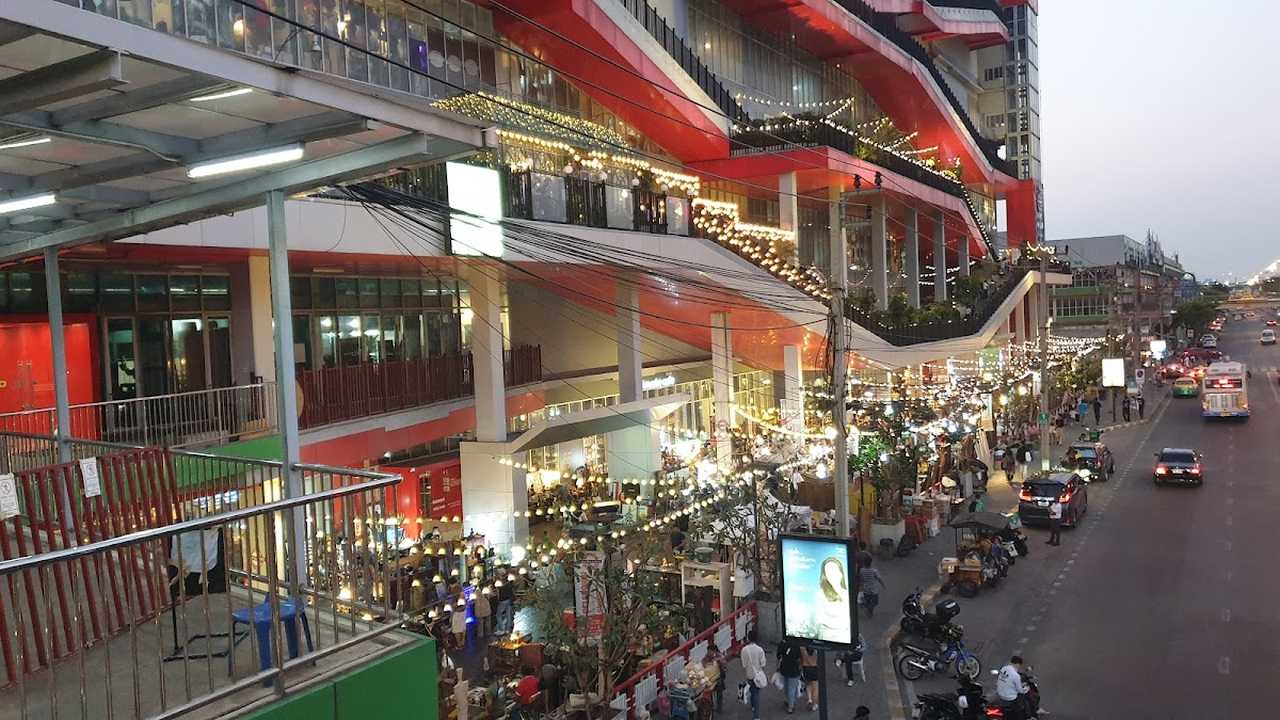 One of the world’s largest weekend markets with over 8,000 stalls selling clothing, antiques, home decor, plants, street food, and handmade crafts.
One of the world’s largest weekend markets with over 8,000 stalls selling clothing, antiques, home decor, plants, street food, and handmade crafts. -
Pratunam Market – A bustling wholesale market offering trendy clothing, accessories, and fabrics at unbeatable prices, ideal for bulk buyers and fashion enthusiasts.
-
Asiatique The Riverfront – A lively night market by the river, blending shopping, dining, and entertainment with a beautiful waterfront setting and cultural shows.
14. How do I get a SIM card in Bangkok?
SIM cards can be purchased at the airport, convenience stores, and mobile shops. Major providers include AIS, DTAC, and TrueMove. A passport is required for registration.
15. What is the best way to get to Ayutthaya from Bangkok?
Ayutthaya, a historical city, is about 80 km from Bangkok and can be reached by:
- Train – Cheap and scenic (1.5 to 2 hours).
- Minivan – Convenient option from Victory Monument.
- Boat cruise – A scenic but pricier alternative.
- Taxi or Private Tour – Comfortable but more expensive.
16. Can I drink tap water in Bangkok?
It is not recommended to drink tap water in Bangkok. Always opt for bottled or filtered water, which is widely available.
17. How do I book tickets for BTS and MRT?
You can buy single journey tokens at the station or get a Rabbit Card (for BTS) and MRT Card for multiple trips.
18. Are there any religious places to visit in Bangkok?
Yes, Bangkok has many beautiful temples:
- Wat Phra Kaew – Most sacred temple in Thailand.
- Wat Arun – Riverside temple with stunning architecture.
- Wat Saket (Golden Mount) – Offers panoramic city views.
19. Is Bangkok safe to walk around at night?
Popular tourist areas are safe at night, but always remain aware of your surroundings. Avoid poorly lit areas and use taxis or ride-hailing services if traveling late.
20. What should I pack for my trip to Bangkok?
- Light, breathable clothing due to the hot weather.
- Sunscreen, sunglasses, and a hat for sun protection.
- Comfortable walking shoes for sightseeing.
- Modest attire if visiting temples (shoulders and knees covered).
- Power adapter for charging electronic devices.
21. What are the major public holidays in Bangkok?
Thailand observes many holidays, including:
- Songkran Festival (April 13-15) – Thai New Year.
- Loy Krathong (November, exact date varies) – Festival of lights.
- King’s and Queen’s Birthdays – National celebrations.
22. How do I report a lost item in Bangkok?
Report lost items at the nearest police station, airport lost & found, or hotel reception. Public transport systems also have dedicated helplines for lost belongings.
23. Is there a dress code in Bangkok?
There’s no strict dress code, but modest clothing is required when visiting temples. Shorts, tank tops, and flip-flops may not be allowed in certain religious sites.
This FAQ guide should help you plan a smooth and enjoyable trip to Bangkok. Whether you're here for sightseeing, shopping, or food adventures, Bangkok has something for everyone. Enjoy your trip!



